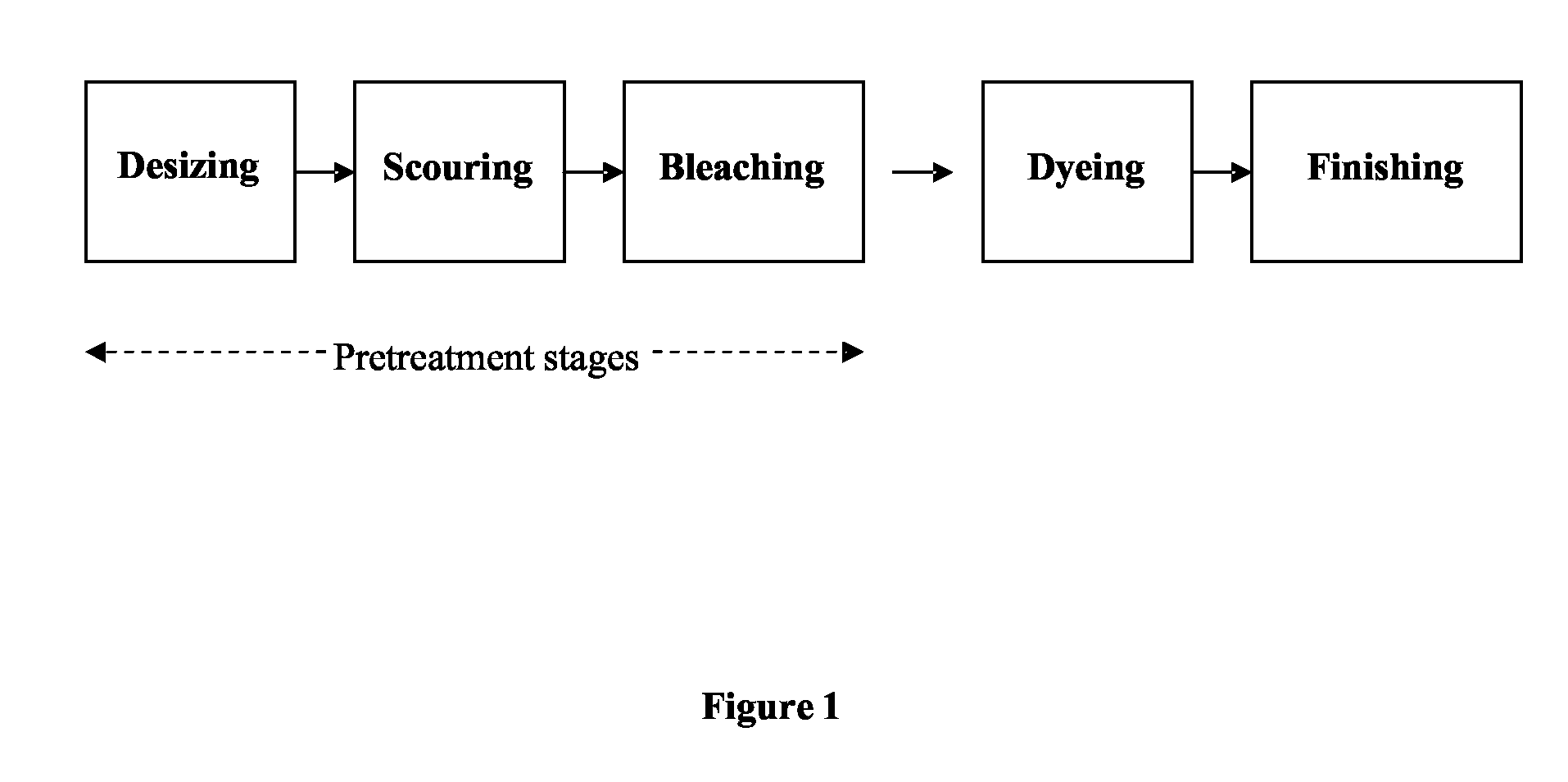Process For Pretreatment of Cellulose-Based Textile Materials
- Summary
- Abstract
- Description
- Claims
- Application Information
AI Technical Summary
Benefits of technology
Problems solved by technology
Method used
Image
Examples
example 1
Determination of Enzyme Activities
[0088]The enzyme activities of different commercial esterases, pectinase and protease were determined. The enzymes were Experimental polyesterase (Genencor International, Inc.), Optimyze esterase (Buckmann Laboratories, Inc.), Lipase PS (Amano Enzyme, In c.), Purafect OX E protease (Genencor International, Inc.) and a cellulase-free pool of pectinases isolated at the Technical Research Center (Finland) from Pectinex Ultra SP-L (Novozymes A / S).
[0089]Protease activity was assayed at pH 8 using Protazyme AK tablets (Megazyme International Ireland Ltd., Ireland). α-Amylase was determined according to the method of Ceralpha, ICC Standard no 33 (Megazyme International Ireland Ltd, Ireland). Lipase activity was determined as described in Kontkanen, H., Tenkanen, M., Fagerstrom, R. and Reinikainen, T. (2004) J. Biotechnol. 108, 51-59. Esterase activity was determined by using p-nitrophenylbutyrate as a substrate and as described in Davies, K. A., de Lorono,...
example 2
Treatment of Cotton with Esterases and Protease
[0091]Raw cotton fabric (bed linen 5851, Finlayson Forssa Oy, Finland) was treated with different enzymes and their combinations. 6 g cotton fabric was treated in a laboratory dyeing machine Linitest (Atlas) in 0.1 M sodium phosphate buffer pH 7 in liquid ratio 1:15 at 40° C. for 4 h. Five different types of commercial and experimental enzymes were used in different combinations. The enzymes were Experimental polyesterase (Genencor International Inc.), Optimyze esterase (Buckmann Laboratories, Inc.), Lipase PS (Amano Enzyme, Inc.) and Purafect OX E protease (Genencor International Inc.). The reference treatment was done as the enzyme treatments but without enzyme. Experimental polyesterase, Optimyze and Lipase PS were dosed as nkat of lipase activity per g of fabric. Purafect was dosed as mg of protein per g of fabric. After the treatment the reactions were stopped by rinsing the fabrics twice at 80° C. with water for 10 minutes in liqu...
example 3
Bleaching of Cotton with Dithionite
[0093]Raw cotton fabric (bed linen 5851, Finlayson Forssa Oy, Finland) was bleached with different concentrations of dithionite (Riedel-deHaen). The fabric was placed into the plastics bag. 6 g fabric was flushed with N2 for 15 min. 0.2% (of dry weight of the fabric) EDTA solution (2.5 g / l) was added and the fabric was incubated at 70° C. for 30 min. 0.1%-1% (of d.w. of the fabric) dithionite was supplemented and the fabric was bleached at 70° C. for 1 h. After bleaching the fabric was rinsed two times with 120 ml water at room temperature and air dried. Colour of the fabric was measured with Minolta Chroma Meter using L*a*b* system.
TABLE 3Colour of the bleached fabric.Dithionite concentration %L / Increase of Lb / Decrease of b0.192.2 / 1.314.1 / 2.50.2593.2 / 2.212.8 / 3.50.593.8 / 2.812.0 / 4.40.894.0 / 3.111.8 / 4.61.093.9 / 3.411.6 / 4.9L = lightness, b = yellowness. Values of the untreated fabric: L = 90.9, b = 16.4.
[0094]The bleaching effect, detected as an increas...
PUM
| Property | Measurement | Unit |
|---|---|---|
| Fraction | aaaaa | aaaaa |
| Fraction | aaaaa | aaaaa |
| Fraction | aaaaa | aaaaa |
Abstract
Description
Claims
Application Information
 Login to View More
Login to View More - R&D
- Intellectual Property
- Life Sciences
- Materials
- Tech Scout
- Unparalleled Data Quality
- Higher Quality Content
- 60% Fewer Hallucinations
Browse by: Latest US Patents, China's latest patents, Technical Efficacy Thesaurus, Application Domain, Technology Topic, Popular Technical Reports.
© 2025 PatSnap. All rights reserved.Legal|Privacy policy|Modern Slavery Act Transparency Statement|Sitemap|About US| Contact US: help@patsnap.com


